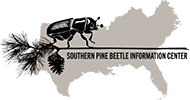Abstract
Most studies of under-bark microclimate have been restricted to observations of a few coniferous trees in wooded locations. The findings of these studies may not generalize to deciduous hardwood trees, or to trees in urban environments. We addressed this limitation with a large data set of under-bark temperatures of ash trees (Fraxinus spp.) in urban and woodlot environments at six different Ontario locations. We observed that daily minimum under-bark temperatures of these deciduous trees are significantly warmer than daily minimum air temperatures in the winter, and that these differences can be important to predictions of overwintering mortality of wood-boring beetles during cold periods. The difference between air and under-bark temperature minima can vary considerably, and we observed that, on 17% of days in the winter of 2008–2009, minimum under-bark temperatures differed by more than 4°C from minimum air temperatures on the north side of woodlot trees (the most conservative value found). With such large differences relatively common, we conclude that assumptions of a constant level of temperature difference between the under-bark microclimate and air temperature are not valid. There were significant differences between under-bark temperature minima in urban and woodlot environments, but the small magnitude of these differences (<0.5 °C) suggests that urban heat island effects will not significantly influence beetle overwintering survival, at least for urban trees bordering a park or yard. Spring maxima under-bark temperatures on the south side of trees were significantly warmer than air temperature maxima, but not for the north side of the trees. This difference leads to significantly faster predicted development times for beetles on the south side of urban trees. However, no difference was found between development times predicted using air temperature and under-bark temperatures for the south side of woodlot trees. Clearly, solar loading leads to faster development rates, and as a result, we suggest urban trees in exposed areas may alter the projected population dynamics of wood-boring insects in wider regions.
Keywords
Agrilus, Deciduous, Microclimate, Phloem, Temperature, Urban
To read the full article please visit the link below:
Vermunt, Bradley, Kim Cuddington, Stephanie Sobek-Swant, Jill C. Crosthwaite, D. Barry Lyons, and Brent J. Sinclair. 2012. “Temperatures Experienced by Wood-Boring Beetles in the under-Bark Microclimate.” Forest Ecology and Management269 (April): 149–57. https://doi.org/10.1016/j.foreco.2011.12.019.
